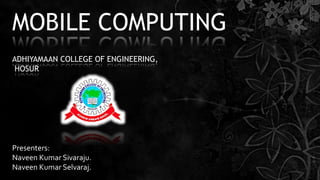
Everything You Need to Know About Mobile Computing
- 1. MOBILE COMPUTING ADHIYAMAAN COLLEGE OF ENGINEERING, HOSUR Presenters: Naveen Kumar Sivaraju. Naveen Kumar Selvaraj.
- 2. So, What is Mobile Computing? Mobile computing is human–computer interaction by which a computer is expected to be used normally during transportation or Simply “Computing on the Go”. With an Objective to Display, collect, and transfer information from a mobile device to an information system using one or a combination of various data transfer methods.
- 3. How did it all start? It all started in 3 april 1981 when… The Osborne 1 was the first commercially successful portable microcomputer, released by Osborne Computer Corporation. It weighed 10.7 kg (23.5 lb), and ran the then-popular CP/M 2.2 operating system. The computer shipped with a large bundle of software that was almost equivalent in value to the machine itself.
- 4. The revolution that took place in the evolution Leading computer manufacturers of that time invested more money on their research, making the portable computers more compact and powerful. After just 33 years of evolution, we today have..
- 5. What does mobile computing require? • A Mobile Computing Device (MCD) • A Wireless network or data connection • An Information System Component • Data or Objective to act on
- 6. Mobile Computing Device (MCD) Mobile computing devices include the following… • Laptops • Netbooks • Smart Phones • Tablets • Wearable Computers
- 7. How are they connected? In the present Mobile computing has become more dependent on Communication. Wireless data connections used in mobile computing take three general forms, • 2G – GPRS/EDGE/CDMA • 3G – WCDMA/HSPA • 4G – HSPA+/LTE/LTE-advanced
- 8. Limitations of wireless Network access still threatens the future of Mobile Computing. Mobile Internet access is generally slower than direct cable connections, using technologies such as GPRS and EDGE, and more recently HSDPA and HSUPA 3G and 4G networks. These networks are usually available within range of commercial cell phone towers. Higher speed wireless LANs are inexpensive but have very limited range.
- 9. Requirements of a MCD • Powerful hardware • Power efficiency • Storage • Connectivity • Large power reserve • Reliable software • Durability
- 10. Technology used in Laptops and Netbooks • These portable version of computers use the same technology as used by desktops. • They are less powerful than desktops but, they posses a built in battery backup enabling the user to use the machine on the go without any external power sources. • Laptops also come withWLAN connectivity enabling the user to connect to a network, some even have built in wireless modems that support 3G and 4G networks for connectivity on the go. • They have a compact chipset with the compact version of processor chips as used in Desktops.
- 11. Smartphones and Tablets • The Hardware of a Smartphone • Smartphones run on 100-2224 MHz processors (single to Quad cored). These processors could not come close to powering a desktop computer, but for the somewhat limited tasks that a smartphone performs those processors are very effective. • The processors used are ARM processors, which have tens of megabytes of onboard memory. MP3 players, routers, printers, and other technologies use these processors.
- 12. Mobile Operating System • Smartphones software is arranged as a “stack”. • The software stack contains: • Application suite- used for simple applications like menu screens and message inboxes • Application execution environment- application programming interfaces, instituted recently so tech-savvy phone-owners can create their own programs • User interface framework- deals with what is actually seen on the screen of the phone • Kernel- manages the hardware (drivers and management systems) • Middleware- libraries of software that enable applications like security, web browsing, and messaging
- 13. Operating Systems There are many mobile operating systems. • Java ME Platform • Palm OS • Symbian OS • Linux OS • Windows Mobile OS • BlackBerry OS • iPhone OS • Google Android Platform
- 14. Wearable Computers • Google Glass is a wearable computer with an optical head-mounted display (OHMD) that is being developed by Google in the Project Glass research and development project, with a mission of producing a mass-market ubiquitous computer. Google Glass displays information in a smartphone- like hands-free format, that can communicate with the Internet via natural language voice commands.
- 15. Future of mobile computing • Better performance will be achieved if NanoTechnology is applied into this field. • Disaster detection can be improved. • Remote computing can be used to access a virtual assistant (AI). • Can be used to take care of the sick and aged people. • Radical technology can me used to make MCDs more powerful and reliable. • Mobile cloud computing can be done to sync massive amounts of data and provide free resources to the public.
- 16. Fiction into Future • It is possible that near human intelligence can be achieved in computers in the near future, But the mystery that’s waiting to be revealed is that “Is it possible to take the AI with us everywhere?” say, the fictional character JARVIS,Virtual Assistant of Iron Man.
- 17. Yes, It’s Possible • The answer for that question lies in Mobile cloud computing technology,There are indeed infinite possibilities out there we just have to explore them.
- 18. THANK YOU “A thought, even a possibility, can shatter and transform us.” ― Friedrich Nietzsche